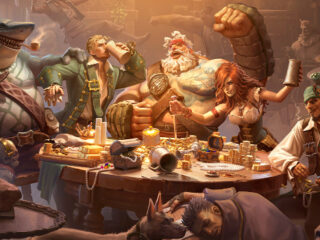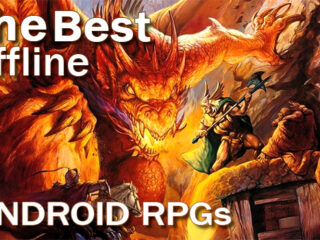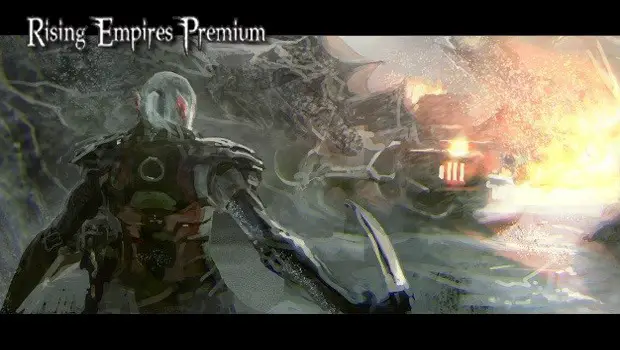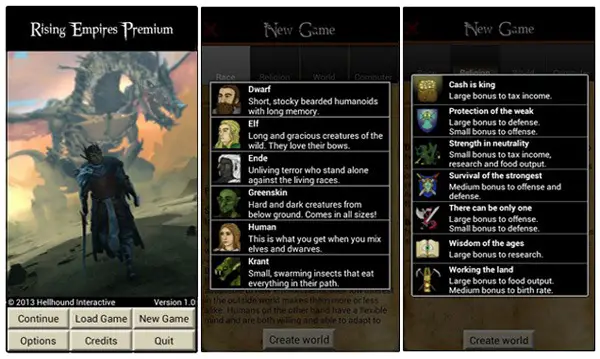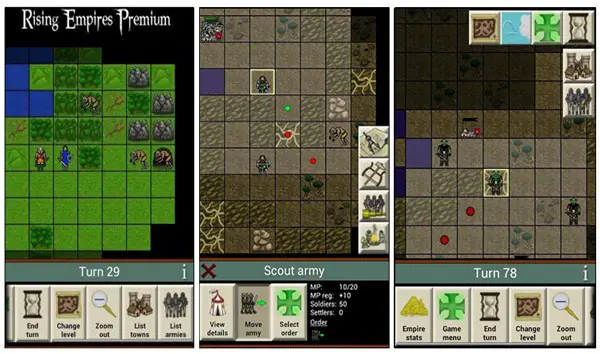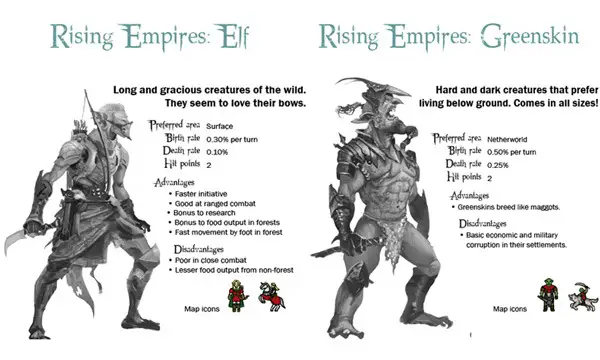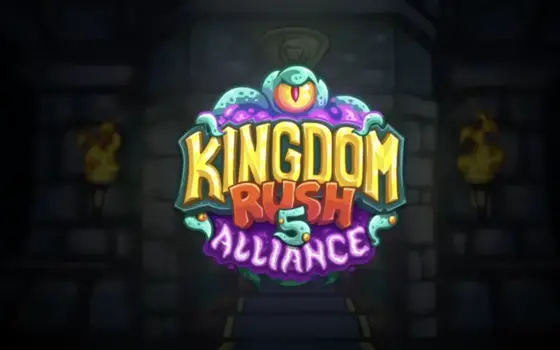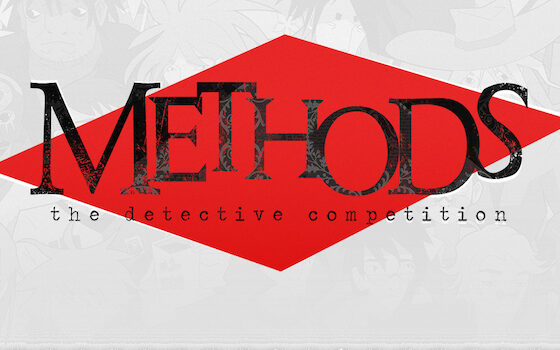4X Excellence Comes to the Tiny Screen
Rising Empires is a 4X turn-based strategy game set in a fantasy world, from Hellhound Interactive. It’s one of the more ambitious entries in the genre for Android, and succeeds at what it sets out to do admirably.
You play as one of six races—humans, elves, dwarves, greenskins (orcs and goblins), the insectoid Krant, or the undead Ende. You also get to choose a religion for your empire, which each give different bonuses depending on the values they focus on. There are two different levels to the map, the surface and the netherworld, connected by tunnels. Some races are more at home above ground, others below it, with important consequences for strategy and for how they interact. You can choose between having one, three, five, or seven rival empires in each game; their races and religions are randomized by default, but you can set them manually. You can also enable or disable “neutral races,” unaligned hostile creatures that roam the map, and set victory conditions.
Classic 4X Mechanics
The building mechanics should be familiar to veterans of classic 4X games like the Civilization series. Towns exploit the squares around them for resources, with their radius growing at higher populations. You can improve squares to make them more productive, while adding buildings in the towns themselves to increase your income, production speed, research points, town happiness, or the quality of military forces raised there. Some structures can be built multiple times for greater effect, but the total number of buildings is limited based on population size.
Settler units can found new towns, or transfer population from one town to another. The seasons change every few turns and no food is produced in the winter, so keeping your growing populace fed requires planning. Each town’s population is a specific number of people instead of a vague abstraction, which is nice, and if a town contains inhabitants of multiple races each has their population size and happiness tracked individually.
Elegant Systems
There’s a sizable technology tree, with many choices for research—weapons, engineering, agriculture, social organization, magic, and much more. Advancing technology gives you access to things like new buildings, more extensive square improvements, and better stats and new abilities for your soldiers.
There’s a simple diplomacy system when you encounter other nations, with basic options like signing nonaggression pacts. When diplomacy fails, military forces are built in towns in 500-man companies of different types that can then be assembled into armies. When two armies meet, battles are calculated automatically, according to a fairly detailed system.
Custom Unit Design
You design unit types yourself. For each company type, you can select their name, basic nature—melee or ranged, footmen or cavalry—and how much to spend on different stats like attack, defense, and armor. (You’re free to choose maximum in every category, if you’re willing to spend the money.) Then you can give them additional special traits and abilities—improved discipline and morale, greater tactical acumen, special weapons like pikes or siege engines, and more. You can choose more than one, but they’re not free, and some are mutually exclusive. Some also have drawbacks as well as benefits, such as units that require less pay but are more likely to break and run. Designs are saved for future reuse, though you’ll want to update as technology advances.
This is a remarkable game. The amount of depth and detail surpasses many PC strategy games and is startling on a mobile device. The city-building element is fun, and watching your settlements and empire grow is satisfying in the same way as games like Civilization, providing the same “just one more turn” urge to keep playing.
Elegant Under the Hood
The game gives you some basic guidance on the mechanics as you play. A lot of the nuances, however, aren’t immediately clear. The developers offer a tutorial on their website. I strongly recommend you read it over if you’re new to 4X strategy games. Experienced players of PC strategy should get the hang of it pretty quickly. What’s more the curve is by no means insurmountable even if you haven’t.
While combat outcomes are determined automatically, the system is surprisingly complex and sophisticated, influenced by factors including numerical strength, technology, melee and ranged capabilities, unit abilities, unit types, morale, leaders, terrain, and weather. Each turn, every company attacks a specific company on the other side, and the game tracks the outcomes of each instead of simply treating clashing armies like undifferentiated blob of troops and morale. Afterward, you’re provided with a round-by-round summary that tells you exactly who killed who.
Combined with the customization element, this does a very good job of making combat interesting and entertaining on the tactical level, despite the fact that the actual battle is out of your hands. It also keeps things moving quickly by automating a detailed system that would otherwise require a tedious amount of micromanagement.
Granular World Building
The races are different enough to encourage differences in strategy that make playing them distinct experiences. The variation goes beyond the surface/netherworld split. For instance, humans get significantly more food from plains than forests. The reverse, however, is true for elves, making their optimal strategies and empires very different. Greenskins suffer economic penalties in their cities, making peaceful development less effective. Greenskins and Krant have extremely high rates of reproduction that makes frequent warfare sustainable. Elven Empire, on the other hand, played that way are risking demographic disaster. The Ende are relatively few in number, and their spectral nature makes it difficult for them to interact with the corporeal world effectively. Ultimately they are highly dependent on a larger greenskin underclass for labor and soldiers. With the right abilities, there’s also a chance that members of other races killed by Ende will rise as undead and join them.
The Numbers Matter
Crucially, military units are drawn directly from the population—each company’s 500 men are deducted from their base town’s population until the unit is disbanded, and the damage it takes in battle is reckoned not in an abstract health bar, but in deaths. As a unit suffer casualties its effectiveness declines commensurately, and reinforcements must come from friendly towns. Population growth is (for most races) a gradual process, so you can’t just breed a new population overnight.
War thus has much more meaningful consequences then in most games of this sort, where military units usually only represent an investment in money or production capacity and their fate has little long-term impact on your nation. In Rising Empires, every fifth of a percentage point of a unit’s strength lost is another citizen who won’t be farming or building or adding to your empire’s population growth, ever again. Military defeat—or even costly victory—can have effects far beyond diminished military strength long after the war is over. This intertwines the combat and city-building aspects of the game much more tightly and gives military and diplomatic decision-making an added dimension.
Tolkienesque with a Realistic Twist
The game’s setting is lightly sketched in and is basically archetypal Tolkienesque fantasy. The gameplay, however, makes it feel more evocative. It actually makes sense to play the races as they’re described in the game’s background material. You should greenskins as a barbarian horde warring for loot. Play the Ende as evil overlords who draw power from bloodshed and rule an oppressive empire of slaves, etc…. The rich military customization gives nations, armies, and individual companies more personality. Ultimately, it makes them seem more like inhabitants of a diverse world and less like stacks of numbers. Even drawing manpower from the civilian population to form and reinforce companies helps. It all makes the game’s world seem bigger and more real.
Conclusion
There are a few weaknesses. The diplomacy system is rudimentary and not very interesting. It’s disappointing and, in light of how well-developed many other aspects are, a bit jarring. The controls were awkward for me on a smart phone. I frequently found myself hitting back or cancel for want of precision. 4X really wasn’t made with touchscreens in mind. I had no problems at all playing with a mouse when I ran it on PC via Bluestacks. So this appears to be a hardware limitation (whether of my small screen or stubby ape-like fingers, I’m not sure). It doesn’t make it unplayable, by any means. However, if you’re using a small phone you’d probably benefit greatly from a stylus.
The graphics are basic even for a mobile game, with simple unanimated sprites that would not have looked out of place in the 1980s. The game presents the information the player needs well enough. Some players may even find the retro simplicity appealing. However, if you’re looking for something visually interesting this definitely isn’t it.
These are all minor quibbles in light of the game’s strengths. I’d strongly recommend Rising Empires for anyone who wants a serious 4X mobile strategy game. You’ll be hard pressed to find an Android game that tackles the subgenre with greater success.
Is it hardcore?
#!*&@%, yes.
A very impressive release in the 4X genre and a must-have for hardcore strategy fans.





